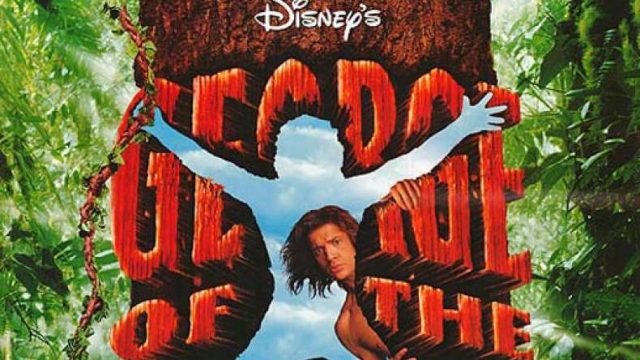Conventional wisdom says that comedy ages faster and worse than any other genre, a debatable enough concept in the broader sense, but particularly, acutely wrong in the case of Disney’s live action adaptation of the Jay Ward animated series George of the Jungle. Though made in 1997, the film feels custom-made for the Tumblr sensibilities of 2018, and it only takes a cursory Google search to find at least a dozen blog posts breaking down the film’s progressive use of the female gaze, feminist theory, and inclusive humor that, when not being meta or absurdist, almost exclusively punches up (except when it literally hits below the belt).
A lot of this can be attributed to co-writer Audrey Wells (1960-2018), a screenwriter/director known for mixing lighthearted romances and comedies with sharp observations about femininity and social constructs. In fact, despite having his name in the title, George is something of a co-lead, alongside Leslie Mann’s Ursula Stanhope. She’s a well-meaning white woman from a family of means engaged to a cartoonishly reprehensible man named Lyle (but it’s okay, because this is basically a cartoon) who has gone into the heart of Africa for a nature documentary. This brings her into contact with George, and from there the film runs on parallel tracks, following George and Ursula in equal measure. He experiences romantic attraction for the first time in his life, while grappling with the strange trappings of civilization, and she recognizes her wants and desires which stand in opposition to her controlling mother and the toxic high society that she represents.
There are two bits in particular that stand out as surprisingly insightful and sharp satire, not just for a ’90s kids movie, but in general. The first occurs at a lavish engagement party thrown by Ursula’s parents, in a scene where her mother is talking to the mayor. He says that it’s not to get away from City Hall and be around “normal people for a change.” It’s an amusing enough bit of juxtaposition, but it’s the mother’s follow up which has a little more sting: “Well, we are perfectly normal, I assure you — in an exceptional way, of course.” It’s only a step up from the previous joke, cutting to the quick of a certain upper class liberal mindset, but it has nothing on a throwaway line the Narrator has in an earlier scene. Since George came over from Africa in nothing but a loin cloth, his only other clothing options are whatever is in Ursula’s closet, prompting her to take him shopping. The narrator then observes “Being of a conservative mind regarding gender roles, Ursula Stanhope wasted no time in taking George of the Jungle to a fine haberdasher.” It’s tossed off so casually, but it’s an utterly uncompromising and incredibly specific critique of that upper class liberal mindset from before, and one that has aged very well into an age of aggressively socially conscious criticism.
And while the film isn’t as smart or challenging about race as it is other subjects, it isn’t an embarrassment, either. There are enough African characters to allow for some diversity of personality among the jungle guides, and there’s even a moment in a police lineup where there are a few tribesmen, but also a couple of dudes in shorts and t-shirts. There’s also one especially pointed scene highly critical of the White American assumption of Africa as a backwards continent, where Lyle is trying to condescendingly win over the guides he has pissed off with a handful of crummy trinkets, and takes a picture with a cheap polaroid camera, explaining that it takes “magic pictures,” only to be immediately put in his place when one of the guides shows off his 35mm Leica with a detachable lens mount. Like I said, it’s not as nuanced, but it’s not actively racist (unlike, say, Ace Ventura: When Nature Calls, which came out 2 years earlier).
All of this to say nothing of the film’s extremely silly, sometimes absurdist sense of humor. There’s slapstick, wordplay, comedy of manners, and quite a lot of fourth wall-breaking meta gags. Most distinctively is the film’s use of the Narrator as a character, one who interacts with, guides, and critiques the characters on screen. There are two particular highlights of this, the first being:
NARRATOR: When they finally beheld the mighty Ape Mountain, they reacted with awe!
ALL: Awwww!
NARRATOR: I said “awe.” A-W-E.
ALL: Ooooh!
NARRATOR: That’s better.
And then, of course, the legendary fight, where two villains kidnapping the talking ape named Ape angrily demand that the Narrator tell them how to get to where they’re going. There are threats, things escalate, and the Narrator runs them through fast forward until they apologize. (“Thor, were you fightin’ with the Narrator?” “He started it!” “Did not!” “DID TOO!”)
On top of all of this, the movie has a very kind heart, taking time to develop the feelings between George and Ursula beyond the nebulous, cinematic “love at first sight.” The movie takes its time to foster a genuine sense of connection, and making it clear that part of Ursula’s attraction is based on the fact that George makes her feel safe. He’s a study in non-toxic masculinity, and I can’t think of anything more 2018 than a movie where that’s a priority.

